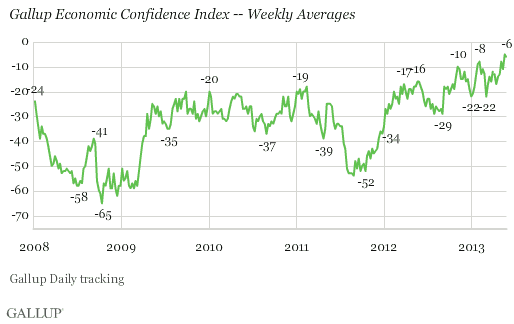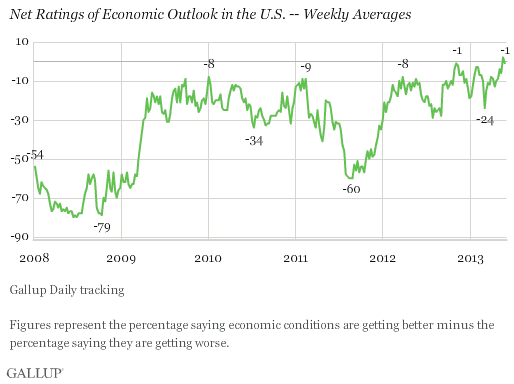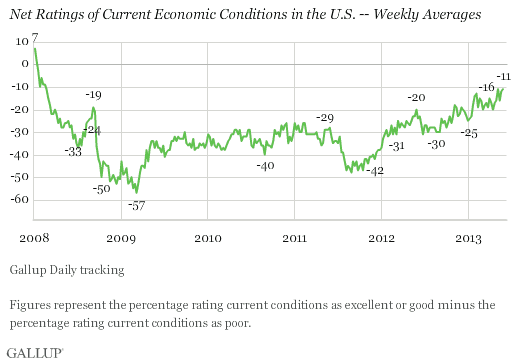WASHINGTON, D.C. -- Gallup's U.S. Economic Confidence Index was -6 last week, staying near the five-year weekly high of -5 from the prior week. The recent level is the most upbeat U.S. consumers have been since Gallup began tracking U.S. economic confidence daily in 2008.

Gallup's Economic Confidence Index is based on Americans' ratings of current economic conditions in the United States as well as their assessments of whether the economy is getting better or worse. The index has not crossed into positive territory since Gallup began Daily tracking of economic confidence in January 2008. Gallup measured Americans' confidence in the economy on a monthly basis from 2001 to 2007, and on an occasional basis prior to that, though methodological differences between the tracking and nontracking surveys do not allow for precise comparisons of the results from each. Nonetheless, the last time the index was in net positive territory was from late 2006 through early 2007.
Looking at the outlook component of the index, Americans' net rating of the economy's direction dipped to -1 last week after crossing into positive territory the prior week -- which was the first time Americans' weekly net economic outlook had been positive in more than five years of Daily tracking. Last week, 47% of Americans said the economy was getting better and 48% said it was getting worse.

Americans' net assessments of current economic conditions, at -11 last week, remain in negative territory, but are as positive as they have been since early 2008. The current reading reflects 21% saying current economic conditions are excellent or good and 32% saying they are poor.

Implications
Gallup's Economic Confidence Index has been edging closer to positive territory in recent weeks after residing in negative territory for more than six years. There are multiple factors that may have contributed to this recovery in Americans' confidence in the economy this year, including surging U.S. stock prices, higher housing prices, lower gas prices, and positive employment news. These positive signs apparently were enough to help Americans' confidence in the economy rebound quickly after the fiscal cliff and budget sequestration debates.
While Americans' confidence in the economy has been stronger so far this year than in prior years, there are political and economic events in the months ahead that will likely test Americans' higher levels of confidence. More federal agencies are announcing and implementing their plans to furlough employees in response to automatic sequestration budget cuts, which could negatively affect Americans' views of their personal finances and the overall U.S. economy. The Federal Reserve may cut back its bond buying program or make other policy changes, which could cause U.S. stock prices to slip. There may also be a contentious debate in Washington this summer or fall over raising the debt limit, with Republicans expected to demand spending cuts as part of a deal to raise the debt ceiling.
Additionally, business owners may decrease hiring and let more employees go in anticipation of health insurance requirements as part of the Affordable Care Act, which also could negatively affect Americans' confidence in the economy.
Gallup's Daily tracking of U.S. economic confidence will show whether Americans' confidence will be shaken as a result of these challenges or whether the positive momentum will continue.
Gallup.com reports results from these indexes in daily, weekly, and monthly averages and in Gallup.com stories. Complete trend data are always available to view and export in the following charts:
Daily: Employment, Economic Confidence, Job Creation, Consumer Spending
Weekly: Employment, Economic Confidence, Job Creation, Consumer Spending
Read more about Gallup's economic measures.
View our economic release schedule.
Survey Methods
Results for this Gallup poll are based on telephone interviews conducted May 20-26, 2013, on the Gallup Daily tracking survey, with a random sample of 3,540 adults, aged 18 and older, living in all 50 U.S. states and the District of Columbia.
For results based on the total sample of national adults, one can say with 95% confidence that the margin of sampling error is ±2 percentage points.
Interviews are conducted with respondents on landline telephones and cellular phones, with interviews conducted in Spanish for respondents who are primarily Spanish-speaking. Each sample of national adults includes a minimum quota of 50% cellphone respondents and 50% landline respondents, with additional minimum quotas by region. Landline telephone numbers are chosen at random among listed telephone numbers. Cellphone numbers are selected using random digit dial methods. Landline respondents are chosen at random within each household on the basis of which member had the most recent birthday.
Samples are weighted to correct for unequal selection probability, nonresponse, and double coverage of landline and cell users in the two sampling frames. They are also weighted to match the national demographics of gender, age, race, Hispanic ethnicity, education, region, population density, and phone status (cellphone only/landline only/both, cellphone mostly, and having an unlisted landline number). Demographic weighting targets are based on the March 2012 Current Population Survey figures for the aged 18 and older U.S. population. Phone status targets are based on the July-December 2011 National Health Interview Survey. Population density targets are based on the 2010 census. All reported margins of sampling error include the computed design effects for weighting.
In addition to sampling error, question wording and practical difficulties in conducting surveys can introduce error or bias into the findings of public opinion polls.
For more details on Gallup's polling methodology, visit www.gallup.com.
